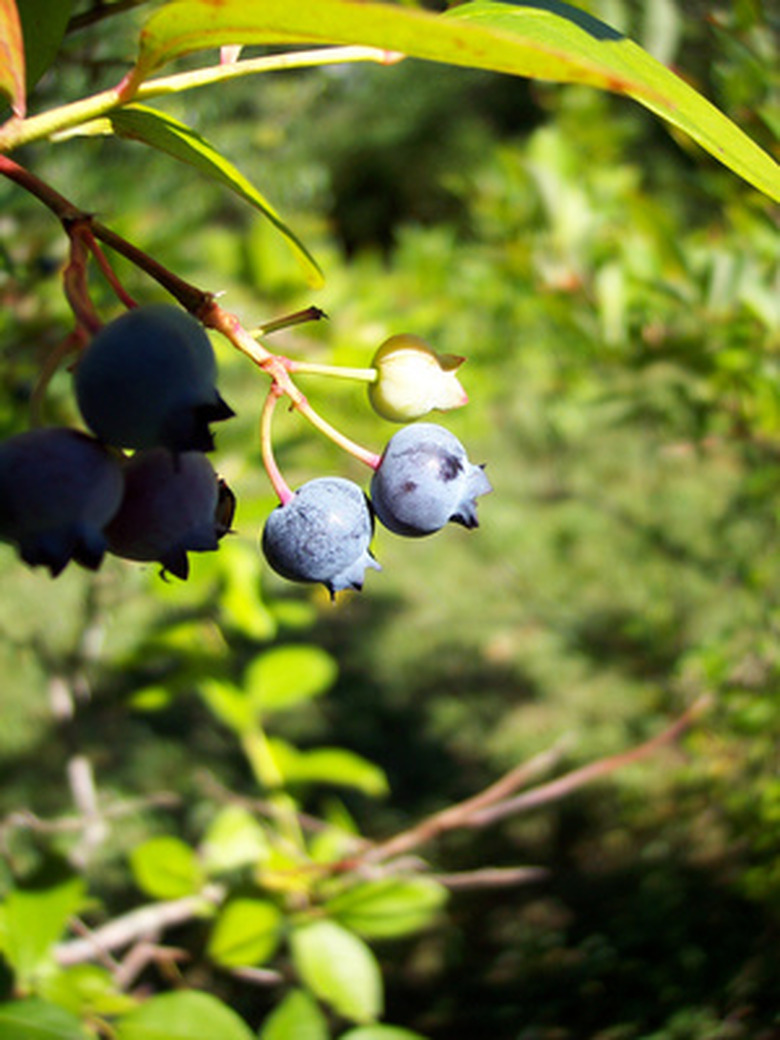How To Identify Different Types Of Blueberry Bushes
Blueberry bushes are not only attractive plants for your landscape, but they also produce thousands of edible berry-like fruits that you can eat fresh or use in making jams, syrups, pies, pancakes, muffins and other baked goods. Blueberries are native to North America, with some species originating from Europe and Asia. Four main types of blueberry bushes exist, which include highbush, half-high, lowbush and rabbiteye blueberries. When selecting blueberry bushes to plant, select the correct type for your climate.
Step 1
Identify highbush blueberries (Vaccinium corymbosum) by their larger size, growing 6 to 12 feet tall. You'll see highbush blueberries growing in a wide range of climates and producing larger blueberries that can be more than 1 inch wide. Highbush blueberries are usually the variety grown commercially for their fruit. Common highbush blueberries include Duke, Bluecrop, BlueRay and Chandler.
- Blueberry bushes are not only attractive plants for your landscape, but they also produce thousands of edible berry-like fruits that you can eat fresh or use in making jams, syrups, pies, pancakes, muffins and other baked goods.
- Four main types of blueberry bushes exist, which include highbush, half-high, lowbush and rabbiteye blueberries.
Step 2
Spot half-high or hybrid blueberry bushes by their 2- to 4-foot height and medium fruit size. Half-high blueberries are hybrids of highbush and lowbush blueberries and are able to grow in colder climates. Half-high blueberries have a sweet or wild blueberry flavor, and their leaves always turn a shade of red in the fall. Popular half-high blueberry bushes include Polaris, Northcountry, Northblue and Chippewa.
Step 3
Look for a blueberry bush that's only 1- to 2-feet tall with a low-growing habit to identify the lowbush blueberry variety (V. angustifolium), also called the wild blueberry. Lowbush blueberries tend to look more like groundcover instead of bushes, spreading via underground runners as they grow. Common lowbush blueberries include Brunswick and Burgundy.
- Spot half-high or hybrid blueberry bushes by their 2- to 4-foot height and medium fruit size.
- Half-high blueberries are hybrids of highbush and lowbush blueberries and are able to grow in colder climates.
Step 4
Identify rabbiteye blueberry bushes (V. ashei or V. virgatum) growing in hotter climates. The rabbiteye blueberry bush is also recognizable by its height, growing taller than the highbush blueberries, up to 15 feet tall. Rabbiteye blueberries are usually grown in USDA Hardiness Zones 7 through 9, where winter temperatures rarely get as cold as 5 degrees F. Some common rabbiteye blueberry varieties are Brightwell, Tifblue and Briteblue.
Tip
You'll see lowbush blueberries growing in colder climates, tolerating winter temperatures down to -35 degrees F. They do not grow in warmer regions that don't experience freezing temperatures during the winter season.
Warning
Don't confuse the northern highbush with the southern highbush. The southern highbush is grown in warmer climates, usually no colder than Zones 5 or 6, where winter temperatures rarely dip down to -15 degrees F. Northern highbush blueberries can be grown in much colder regions, however, even down to Zone 3, where minimum temperatures can be as cold as -35 degrees F. Also, most southern highbush blueberries keep a greenish leaf color in the fall, while northern varieties turn yellow, orange, red or burgundy. Popular southern highbush blueberries are O'Neal, Jubilee and Sunshine Blue.
